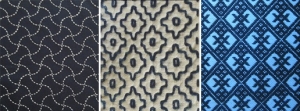The technique was probably originally used to repair worn clothing and to quilt different layers. It is alleged that the work of the famous artist Katsushila Hokusai (1760-1849) and his book New Forms for Design (1824), influenced many sashiko patterns. In the Edo period (1603-1868), a special coat was worn by firefighters, called a hikeshi sashiko hanten, which was made of several layers of cloth and densely stitched, in order to protect the wearer against the fire. Comparable fireman's hoods were also made. Sashiko was also used to decorate the corners of wrapping cloths called furoshiki.
Some important types of sashiko are being distinguished: moyouzashi sashiko, hitomezashi sashiko, kogin sashiko, and shonai sashiko. If the stitches are dyed over with indigo, it is called kakurezashi.
By the beginning of the twenty-first century sashiko had become popular in many other countries around the world and was often used together with patchwork or appliqué, or as an alternative to quilting.
Because of its more practical origins,, namely the 'little stabs' used to repair and strengthen garments, and its application for quilting, Sashiko is sometimes not classed as a form of (Japanese) embroidery. It is hence sometimes classed as a form of structural stitching.
Source: BRISCOE, Susan (2005). The Ultimate Sashiko Sourcebook: Patterns, Projects and Inspirations, Newton Abbot: David & Charles.
Digital source of illustration (retrieved 5 july 2016).
SA

